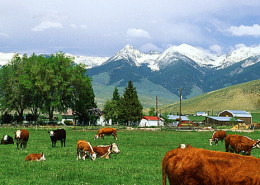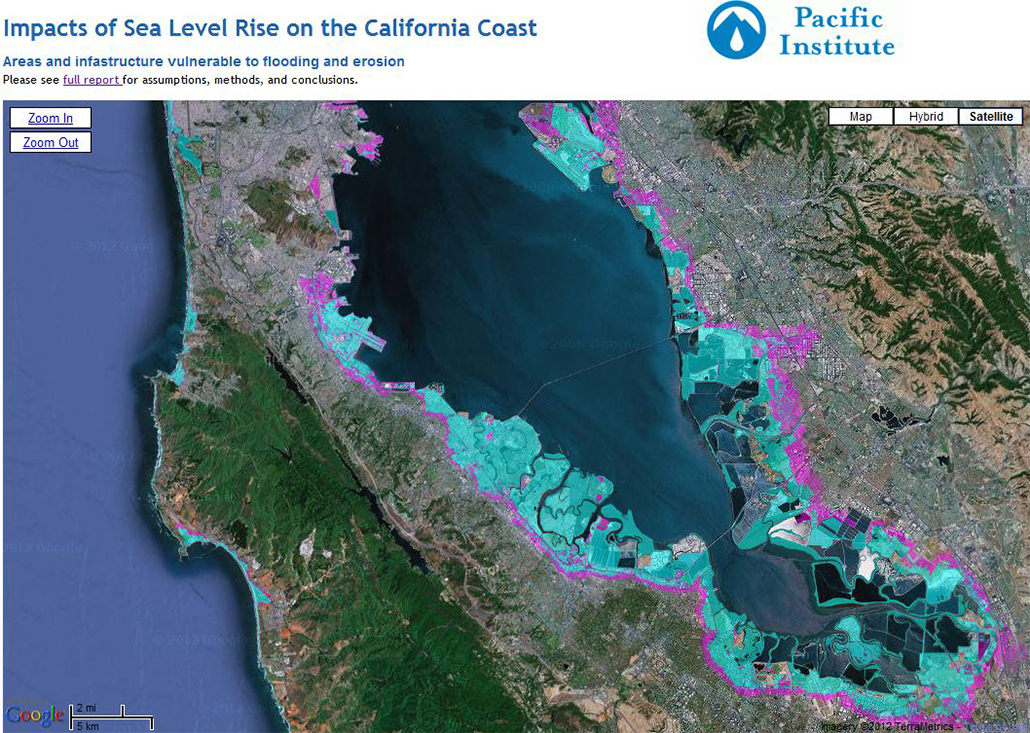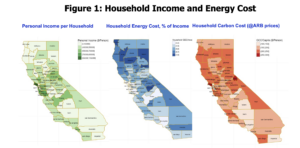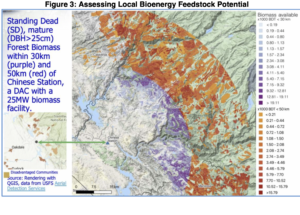Clean Energy Transition for Disadvantaged and Tribal Communities in the Sierra Nevada
Place: California • Date: 2018-2023 • Partner: USDA
Project Summary
The Sierra Nevada has a variety of important challenges related to livelihood and climate risks. The majority of rural communities in this region are classified by California as Disadvantaged (DACs), with incomes in the lowest quartile and above average carbon-fuel energy dependence. Moreover, Tribal and non-Tribal DACs in this region face much higher-than-average threats of wildfire to life, property, and public health (Figure 1). This project was designed to deliver clean biomass energy conversion to such communities, mitigating local fire risk while supporting local employment, improved air and water quality, and energy independence.
Efficient, community-scale biomass energy conversion is a relatively recent innovation, and bioenergy remains well below its potential to contribute to California’s climate mitigation goals (Figure 2). Moreover, promoting cutting-edge clean energy technology in remote communities is challenging. Thus, our project strategy is anchored to the expertise and experience of one of the state’s leading economic and technology research institutions. Primary implementation responsibility will fall to ARE, a consultancy with 20 years of domestic and international experience assessing and advising on energy, environmental, and inclusive economic development policy. For local engagement, ARE will be responsible for developing institutional relationships and recruiting community facilitators. JBEI, the premiere bioenergy research facility of the US National Laboratories, will provide all technical assistance for scaling, adaptation, and permitting of the core biomass energy conversion technology.
This project aims to establish biofuel enterprises capable of reimbursing capital expenditures in the course of facility operation. Their self-financing design relieves pressure for longer term public support while significantly improving prospects for sustained adoption and diffusion of this technology. Moreover, their local ownership creates a range of avenues by which biofuel revenues could support other local public initiatives, particularly attractive in Sierra DACs.
This project comprises a 3-year strategy for community-based biofuel enterprise development, with detailed information on the first year (Phase 1) and general discussion of the Phase 2 follow-up. Each facility will be designed to take advantage of the many economic and social benefits of directing biomass to a net negative carbon pathway. In addition to displacing costly, polluting fossil fuels, the project will create new local jobs and support technical training and other workforce skill development. The strategic plan has been proposed for priority funding by USDA and nominated by UCB for its special Land Grant Funding allocation.
- [Year 1 / Phase 1]: Conduct a comprehensive analysis of Sierra Nevada Disadvantaged Communities (DACs), including local forest biomass availability, institutional / infrastructure capacity, and energy use patterns. Identify ten pilot communities subject to these criteria for facility development. Develop implementation plan through outreach and negotiation with local governments, community-based organizations, and technical vocational education and training (TVET) resources (e.g., California State Universities / Junior Colleges). Provide complete planning support to each pilot community, including staffing, land use, engineering, finance, marketing, and legal services.
- [Year 2 / Phase 2]: Begin implementation in 10 target communities, leveraging community partnerships (including TVET institutions) to draw core operational staff from local labor markets. Target facilities for production commencement in six months, and rigorously evaluate operations for the following six months. Based on these results, Year 3 will target expansion of the program.
- [Year 3 / Phase 2]: Build on the pilot results to scale up community bioenergy development and establish a non-profit California BioEnergy Network (CBEN) to promote knowledge exchange and partnership around the state. Pursue a target of 100 CBEN members (localities with intent to implement or evaluate the technology locally) in its first year of operations.
This proposal builds on an ongoing partnership funded by CAL FIRE. Now in its fifth and final year, CAL FIRE has committed $5.7M to the development and prototyping of the carbon-negative bioenergy conversion technology that will be deployed in our pilots. BEAR’s other partners on that project, including the patent holder (SUNY Research Foundation) and primary rights holder (CARIBOU Biofuels), are not direct participants in this DOC project – but strongly endorse the strategy described here.
A sustainable supply of forest biomass will be essential to the viability of each community bioenergy project, taking explicit account of the economic and environmental costs of accessing this resource. For the proposed project, we will use our own advanced GIS analysis tools to determine agricultural and forest biomass feedstock accessibility for each eligible community. ARE have significant spatial data science experience including our own search and rendering tools to support this activity. As the following figure makes clear, areas in California with high agricultural and forest biomass include many communities with relatively low incomes and high energy costs. Using a combination of USFS agricultural and forest biomass density data, socioeconomic statistics for California, and our own advanced GIS rendering tools, we can identify bioenergy feedstock quantities with a given radius of any community.
Most Recent Entries

Low Carbon Biomass Conversion in the Sierra Nevada










